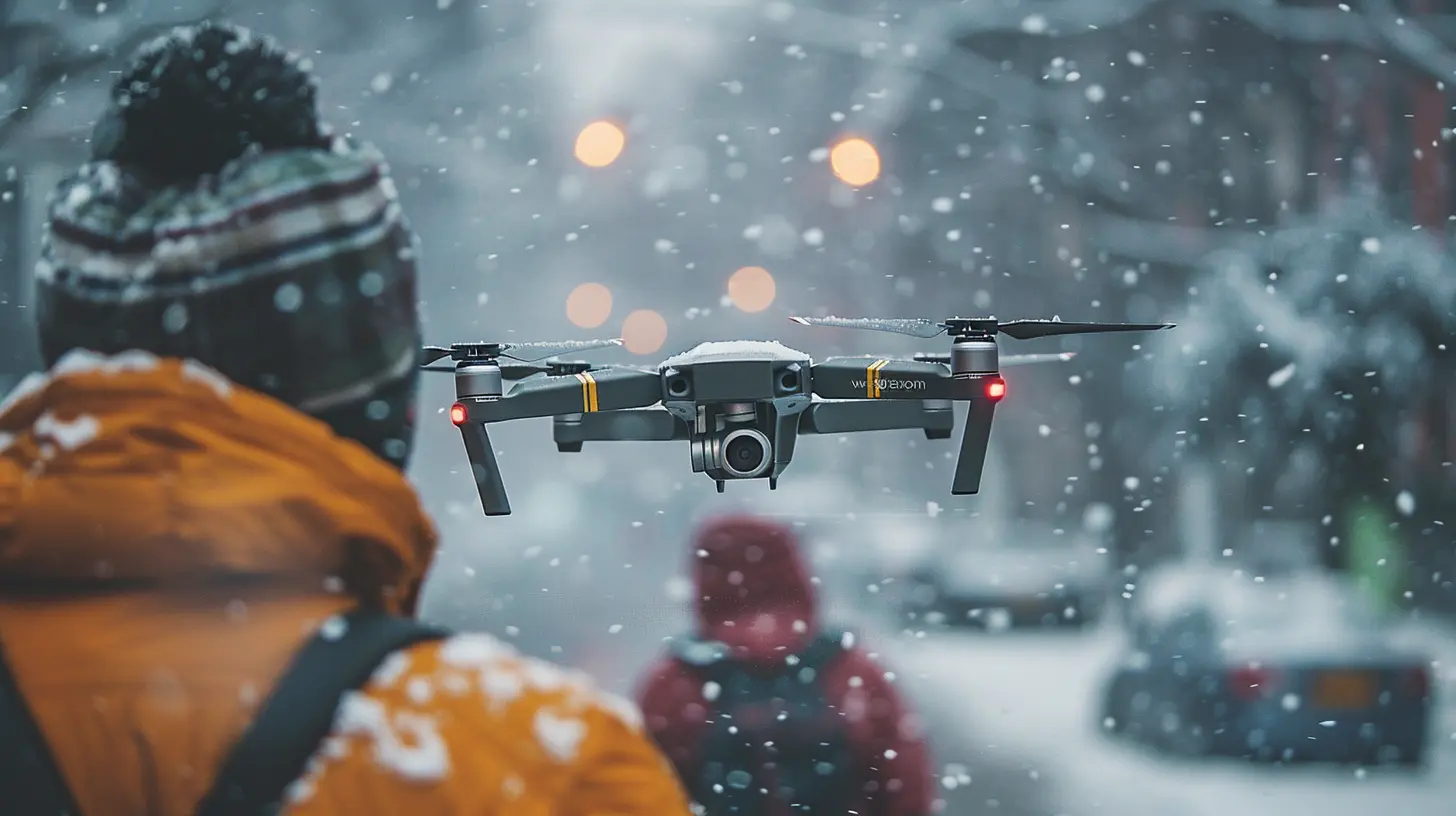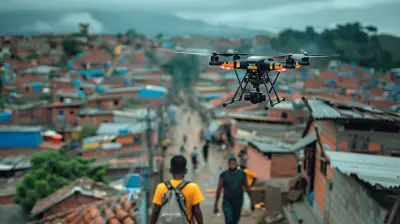Flying Drones in Challenging Weather: A Survival Guide
2 November 2025
So, you bought a shiny new drone, watched a few YouTube tutorials, maybe even aced those crisply edited cinematic shots on a sunny day. But then comes reality — wind, rain, fog, and even snow. Sound familiar?
Flying drones in challenging weather isn't just risky; it's a whole different ballgame. You’re not just battling physics anymore — you're fighting nature. But don’t worry, we’re about to dive deep into how to keep your drone airborne and your footage phenomenal, no matter what Mother Nature throws at you. Buckle up, it’s going to get windy.
Why Weather Matters More Than You Think
Let’s get this straight — drones are high-tech marvels, but they’re not invincible. Rain can short-circuit electronics, wind messes with flight stability, and low temperatures sap battery life like a vampire at a blood bank.The biggest problem? Weather affects not only the drone but also the pilot’s ability to make smart decisions quickly.
If you’re serious about piloting drones, you’ll need to be just as serious about understanding the sky. Let's break it all down.
Wind: The Invisible Drone Slayer
How Much Wind Is Too Much?
Wind doesn't seem scary until you're watching your $2,000 drone drifting away into the abyss, ignoring your joystick commands like a rebellious teenager. Every drone model has a maximum wind resistance rating (measured in m/s or mph), and exceeding this can lead to catastrophic failure.As a rule of thumb:
- Consumer drones (like DJI Mini series): Handle up to 10-15 mph breeze
- Advanced drones (Mavic, Autel EVO, Skydio): Can survive 20-25 mph
- Industrial drones: Sometimes built to withstand 30+ mph
Wind is trickier than it looks. Gusts, updrafts, and variable flow can all cause sudden shifts mid-flight. And don’t forget the wind is often stronger at higher altitudes.
Tip: Always Fly Into the Wind First
Flying into the wind on your way out ensures that, if something goes wrong or your battery starts dwindling, you’ll have a tailwind on the way back — making it easier and faster to return.
Rain: Your Drone’s Kryptonite
Can Drones Fly in the Rain?
Short answer? Most can’t. Long answer? It depends.Water-resistant does not mean waterproof. A few high-end or industrial drones may be rated for wet conditions, but most consumer drones aren’t. Even light drizzle can spell electrical doom.
Water doesn’t just damage internal components, it can also fog up your camera lens, adding a dreamy filter you definitely didn’t ask for.
Tip: Keep Silica Gel Packs in Your Drone Case
If your drone gets even a little wet, drying it out with towels isn’t going to be enough. Silica gel packs absorb moisture like a sponge in a desert. Keep a bunch in your case for unexpected weather ambushes.
Snow: The Silent Drone Killer
Snowfall Equals Trouble
Flying in snow can be beautiful — those slow, drifting flakes make for cinematic footage. But looks can be deceiving. Snow, especially wet snow, melts on contact, causing the same problems as rain. Plus, it can trick your drone’s obstacle sensors, leading to crashes.And let's not even start on cold battery performance. Spoiler: it plummets.
Tip: Pre-Warm Your Batteries
Don’t just yank your drone out of a freezing car trunk and fly. Cold batteries discharge quicker and can lead to sudden shutdowns mid-flight. Keep them warm in your pocket or use a battery warmer (yes, they exist).Fog and Low Visibility: Losing Sight of the Mission
Flying Blind Isn’t Brave — It’s Risky
Fog is the stealthy saboteur. It doesn’t fry your circuits or blow your drone off course, but it can mess with your line of sight and GPS signals. If you can’t see your drone, you shouldn’t be flying it.Plus, moisture builds up fast in foggy conditions — again, not great for the motors, camera, or circuit board.
Tip: Use Anti-Fog Spray on the Camera Lens
Just like scuba divers do, apply a light anti-fog treatment to your drone's camera lens before flying in misty or humid environments. It’s a cheap trick that might save your shoot.Cold Temperatures: Goodbye Battery Life
Why Cold = Fast Draining Batteries
Lithium-polymer (LiPo) batteries hate cold weather. Below 50°F (10°C), performance starts dipping. Go colder, and you’re entering no-fly territory. Cold temps slow down chemical reactions inside the battery, reducing voltage and capacity.Your drone may take off with 100%, only to die mid-air with 40% showing. Not ideal.
Tip: Monitor Battery Voltage, Not Just Percentage
Relying on the battery percentage is like trusting a weather app that says “partly cloudy” during a hurricane. Use apps or your drone's telemetry data to track battery voltage for a more accurate read.Heat: Melting More Than Just Ice Cream
When Hotter Isn’t Better
While cold is usually the bigger enemy, flying in extreme heat (above 100°F or 38°C) is no joke either. Batteries overheat, motors strain, and internal components can start to fail. It’s like asking your drone to run a marathon in a sauna.Tip: Limit Recording Time in the Heat
Heat and 4K recording don’t mix. Shooting in high-resolution video during hot weather can cause the drone to overheat quickly. Keep clips short and give your drone cool-down breaks between flights.Pre-Flight Checklist for Bad Weather
Let’s pause and build a solid checklist before you even launch into challenging weather. Consider this your drone’s survival kit:1. ✅ Check weather forecast (use aviation-specific apps if possible)
2. ✅ Inspect drone body and propellers for damage
3. ✅ Fully charged and pre-warmed batteries
4. ✅ Firmware and app updates completed
5. ✅ Calibrate compass and IMU before takeoff
6. ✅ Silica gel packs in your kit
7. ✅ Anti-fog lens treatment applied if needed
8. ✅ Set return-to-home (RTH) altitude properly
9. ✅ Keep a visual line-of-sight at all times
10. ✅ Have a plan for emergency landings
Emergency Tips: When Things Go South
Things can — and often do — go wrong. The key is to react quickly and calmly.- Lost Visual: Initiate return-to-home immediately
- Sudden Rain: Land ASAP, dry with microfiber and store with silica gel
- Strong Wind: Descend to lower altitude where wind is usually calmer
- App Freeze: Turn on controller auto-pilot (if supported)
Also, always practice emergency procedures in fair weather so muscle memory kicks in when chaos hits.
Weather Apps Every Drone Pilot Should Have
Don’t trust general weather apps — they weren’t built for crazy aerial machines. Instead, check out these drone-pilot-approved tools:- UAV Forecast: Super specific wind, visibility, satellite data
- Windy: Real-time wind maps with layer-by-layer breakdown
- Kittyhawk (Aloft): Weather + airspace alerts + flight logging
- DroneCast: Simplified weather forecast tailored for drones
Pro tip: Cross-reference a few apps for the full picture. One app alone isn't gospel.
Flying Smart Is Flying Safe
Let’s face it — the best drone pilots aren’t the ones with the most expensive gear. They’re the ones who know when to fly, how to fly, and when to pack it up and wait for better conditions.Flying in challenging weather isn’t about flexing bravado. It’s about preparation, skill, and a little geeky obsession with meteorology.
Always ask yourself: “Is the shot worth the risk?” If it isn’t, wait. The sky will always be there tomorrow.
Wrapping Up
Flying drones in tough weather may be scary at first — kind of like driving on black ice with bald tires. But with the right knowledge, gear, and instincts, you can capture jaw-dropping footage while keeping your drone safe and sound.Treat weather like your co-pilot: unpredictable, powerful, and never to be ignored. Understand it, respect it, and you’ll keep soaring — rain or shine.
all images in this post were generated using AI tools
Category:
DronesAuthor:

Vincent Hubbard
Discussion
rate this article
1 comments
Lilith Wheeler
Embrace the challenge of flying drones in tough weather! With the right knowledge and preparation, you can turn obstacles into opportunities. Let innovation guide you through every storm. Happy flying!
November 3, 2025 at 4:07 AM

Vincent Hubbard
Thank you for your encouraging words! Embracing challenges is key to mastering drone flying in tough conditions. Happy flying to you too!


